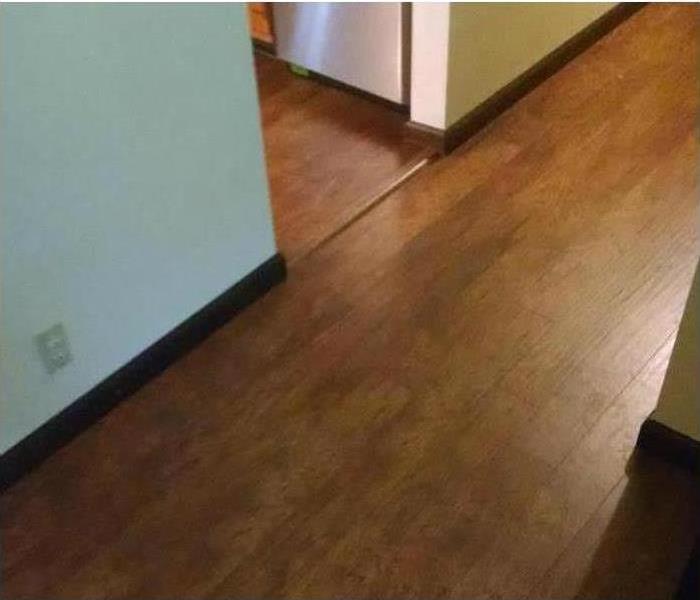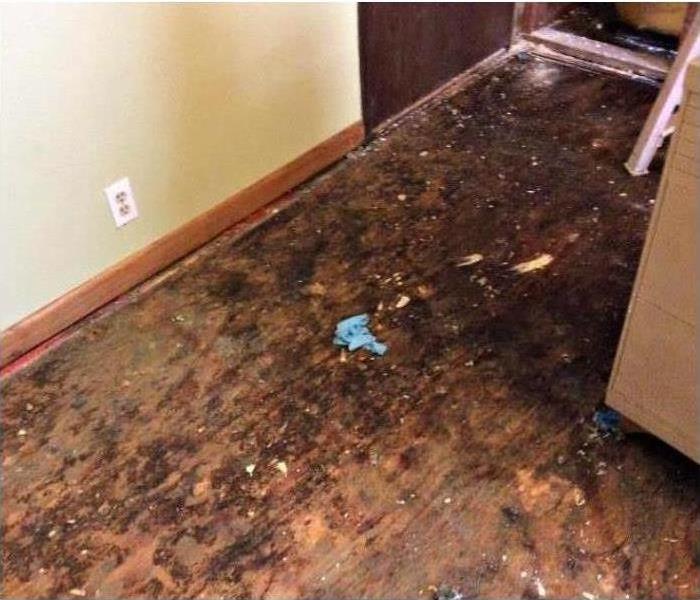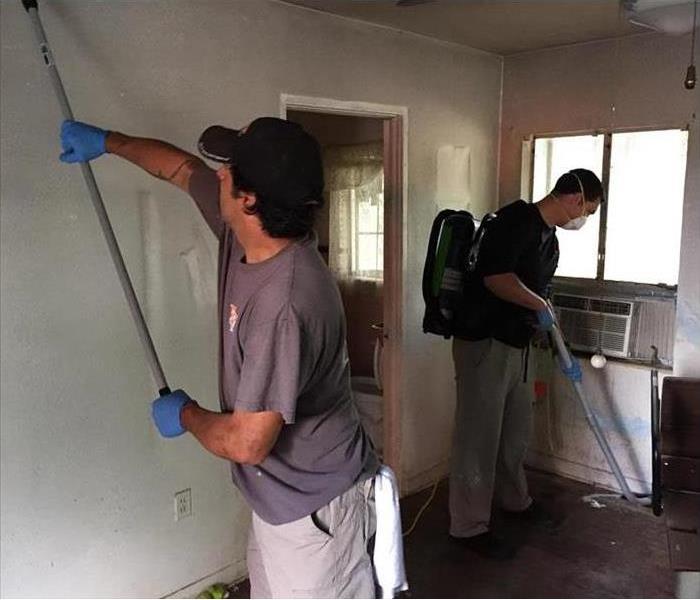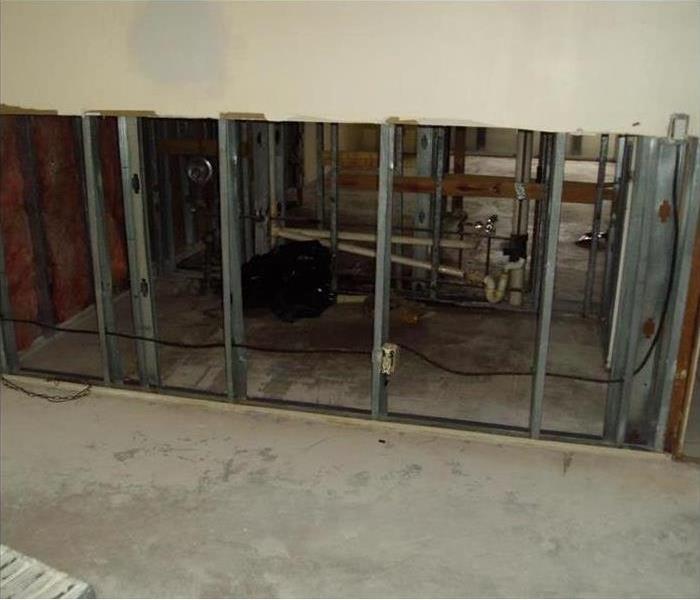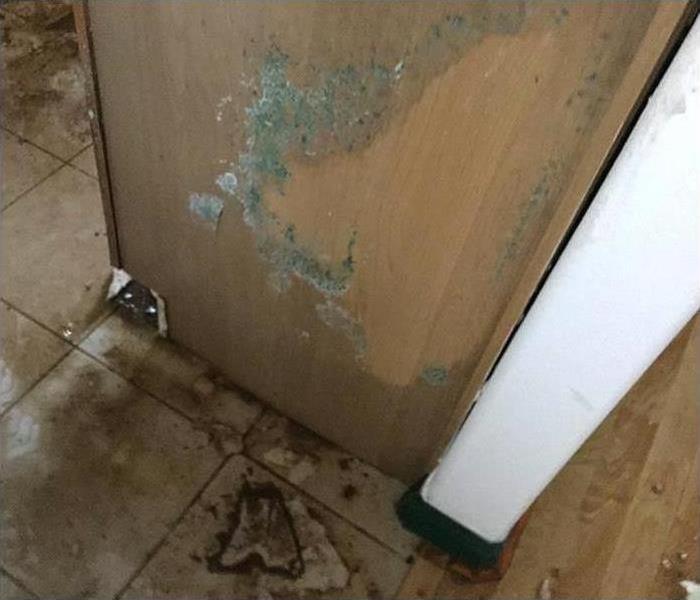Recent Posts
Expert Water Damage Repair and Restoration in Winter Park
2/6/2025 (Permalink)
Water damage can strike your home or business at any time, causing significant stress and costly repairs. Whether from burst pipes, flooding, or leaks, addressing water damage quickly is essential to preventing long-term issues like mold growth and structural deterioration. At SERVPRO©, we specialize in Water Damage Repair and Restoration in Winter Park, ensuring your property is restored efficiently and professionally.
Understanding Water Damage
Water damage can occur for various reasons, including:
Burst or Leaking Pipes – Cold temperatures or old plumbing can lead to unexpected pipe bursts.
Flooding from Heavy Rains – Intense storms can cause water intrusion, leading to soaked carpets, damaged drywall, and structural issues.
Sewage Backups – Blocked drains or septic system failures can cause hazardous water damage.
Appliance Malfunctions – Dishwashers, washing machines, and water heaters can leak and flood rooms.
Roof Leaks – Damaged shingles or clogged gutters can result in water seeping into your home.
Recognizing the signs of water damage early can help minimize costly repairs. Look out for discoloration on walls, musty odors, or peeling paint.
The SERVPRO Water Damage Repair and Restoration Process
When dealing with Water Damage Repair and Restoration in Winter Park, quick action is crucial. Here’s how SERVPRO handles water damage restoration:
1. Emergency Contact
Our 24/7 response team is always ready to assist. The moment you call SERVPRO, we gather crucial details about the situation and dispatch a team to your location.
2. Water Damage Assessment
Our professionals assess the extent of the damage using advanced moisture detection equipment. This helps us determine the best approach for drying and restoring your property.
3. Water Removal
We utilize powerful pumps and industrial-grade vacuums to remove standing water quickly. The faster the water is extracted, the less damage it can cause to your home’s structure and belongings.
4. Drying and Dehumidification
Once the water is removed, our team uses high-powered air movers and dehumidifiers to eliminate moisture trapped in walls, floors, and furniture. This step is crucial to preventing mold growth.
5. Cleaning and Sanitizing
Water damage often brings bacteria and contaminants into your home. We use professional-grade cleaning solutions to sanitize affected areas, ensuring a safe environment for you and your family.
6. Restoration and Repairs
The final step in our Water Damage Repair and Restoration in Winter Park process is restoring your home to its pre-damage condition. This can include minor repairs, such as drywall patching and carpet replacement, or major reconstruction for severely damaged areas.
Why Choose SERVPRO for Water Damage Repair and Restoration in Winter Park?
Fast Response Time – We are available 24/7 to mitigate water damage quickly.
Advanced Equipment – We use cutting-edge technology for efficient water extraction and drying.
Highly Trained Experts – Our team is IICRC-certified and experienced in all types of water damage restoration.
Insurance Assistance – We work with your insurance provider to streamline the claims process.
Comprehensive Services – From initial assessment to full restoration, we handle every aspect of water damage repair.
Preventing Water Damage in Your Home
While professional Water Damage Repair and Restoration in Winter Park is essential after a disaster, preventing water damage can save you time and money. Here are some proactive steps:
Inspect and Maintain Your Plumbing – Regularly check for leaks and replace old pipes before they burst.
Clean Gutters and Downspouts – Prevent water buildup and roof leaks by keeping gutters clear.
Install a Sump Pump – A sump pump in your basement can help prevent flooding.
Monitor Your Water Bill – An unexpected increase may indicate a hidden leak.
Seal Windows and Doors – Proper sealing prevents water intrusion during storms.
Call SERVPRO for Water Damage Repair and Restoration in Winter Park
If your home or business has suffered water damage, don’t wait—call SERVPRO immediately. Our team is ready to provide expert Water Damage Repair and Restoration in Winter Park to restore your property quickly and efficiently. With our professional services, you can trust that your home is in the best hands.
Top-Tier Water Damage Solutions for Winter Park
1/23/2025 (Permalink)
Water damage can happen at any moment, whether due to a sudden storm, a plumbing mishap, or an appliance failure. When the unexpected strikes, having a dependable partner for Water Damage Repair and Restoration is crucial. SERVPRO© is here to help you restore your property quickly and efficiently, giving you peace of mind during a stressful time.
Why Trust SERVPRO for Water Damage Repair and Restoration?
Dealing with water damage is a race against time. The longer water is left untreated, the greater the risk of extensive damage and health hazards. Here’s why SERVPRO is the trusted choice:
Rapid Response: Our team is available 24/7 to tackle emergencies without delay.
Skilled Professionals: We bring certified expertise and experience to every job.
Cutting-Edge Technology: Advanced tools and techniques ensure thorough repairs.
End-to-End Service: From water extraction to full restoration, we handle every step.
Frequent Causes of Water Damage
Understanding the common triggers of water damage can help you take proactive measures:
Plumbing Failures: Burst pipes, leaks, or outdated plumbing systems are frequent culprits.
Appliance Issues: Malfunctions in washing machines, dishwashers, and water heaters can lead to water overflow.
Severe Weather: Intense rainstorms and flooding can overwhelm your property.
Roof Problems: Aging or damaged roofs can allow water to seep in unnoticed.
The Water Damage Repair and Restoration Process
SERVPRO follows a tried-and-true process to ensure effective water damage restoration:
Emergency Contact: Reach out to us anytime to report your situation.
Detailed Assessment: Our experts inspect the damage and develop a comprehensive plan.
Water Extraction: High-powered pumps and vacuums remove standing water.
Drying and Dehumidifying: Industrial-grade equipment eliminates moisture and prevents mold.
Thorough Cleaning: Affected areas are cleaned, sanitized, and deodorized.
Restoration: From minor fixes to major repairs, we restore your property to its original state.
Advantages of Professional Water Damage Repair
Handling water damage on your own can be risky and overwhelming. Relying on professionals offers numerous benefits:
Enhanced Safety: Experts address contaminants and ensure your space is safe to occupy.
Mold Prevention: Quick drying and dehumidification stop mold growth in its tracks.
Comprehensive Solutions: Professionals tackle both visible and hidden issues.
Cost Savings: Swift action reduces the need for expensive future repairs.
Why Prompt Water Damage Repair Matters
Ignoring water damage can lead to severe consequences, such as:
Structural Weakening: Water can compromise walls, floors, and even the foundation.
Mold Infestation: Damp conditions are a breeding ground for harmful mold.
Escalating Costs: The longer the damage lingers, the more expensive it becomes to repair.
SERVPRO of Winter Park: Your Local Experts
For dependable Water Damage Repair and Restoration in Winter Park, SERVPRO is the name you can trust. We understand the specific challenges our community faces and are fully equipped to handle them.
What Makes Us Different?
Community Knowledge: We’re familiar with the unique needs of Winter Park residents.
Tailored Services: Every water damage scenario is different, and we customize our approach.
Insurance Assistance: We coordinate with your insurance provider to make the claims process easier.
Steps to Take Before Help Arrives
If water damage occurs, take these actions to minimize further harm:
Shut Off the Water: Stop the source of the leak if it’s safe to do so.
Move Valuables: Relocate important items to a dry, secure place.
Avoid Hazardous Areas: Stay out of waterlogged rooms with electrical risks.
Improve Ventilation: Open windows and doors to enhance airflow.
Contact SERVPRO for Expert Water Damage Repair in Winter Park
When water damage disrupts your home or business, SERVPRO of Winter Park is ready to restore your property and peace of mind. Call us any time for fast, professional Water Damage Repair and Restoration services.
Don’t let water damage take over your life. Contact SERVPRO of Winter Park today for prompt and reliable assistance!
Experience Complete Recovery with Fire Damage Repair and Restoration in Winter Park
8/6/2024 (Permalink)
Experiencing a fire can be life-altering. The aftermath of such a disaster leaves more than just physical damage—it leaves emotional scars and a sense of loss. At SERVPRO®, our mission is to guide you through this challenging time with comprehensive fire damage repair and restoration services that help you rebuild your property and restore your peace of mind.
Rebuilding Stronger, Together
SERVPRO of Winter Park is dedicated to providing top-tier fire damage repair and restoration services. Using advanced techniques, cutting-edge equipment, and a compassionate approach, we aim to not only restore your property but also rejuvenate your spirit.
Comprehensive Fire Damage Repair Services
The path to recovery from fire damage begins with a thorough assessment. At SERVPRO of Winter Park, our team of experts conducts a meticulous inspection to determine the extent of the damage and create a customized restoration plan. Our comprehensive fire damage repair and restoration in Winter Park includes:
- Structural repairs to ensure safety
- Smoke and soot removal from all surfaces
- Deep cleaning and sanitization of belongings
- Odor elimination using advanced equipment
- Complete property restoration and reconstruction
Our goal is to address every aspect of fire damage, ensuring that your property is safe, clean, and habitable once again.
The Necessity of Professional Fire Damage Restoration
Fire damage brings with it a host of complications, from hazardous soot and smoke residues to water damage from firefighting efforts. Handling fire damage on your own could lead to further issues and health risks. Therefore, engaging professional fire damage repair and restoration services is crucial. SERVPRO of Winter Park employs certified professionals who follow stringent protocols to ensure effective and safe restoration. Our services encompass:
- Immediate assessment and stabilization
- Specialized cleaning techniques and products
- Heavy-duty equipment for odor and soot removal
- Restoration of personal belongings
- Comprehensive rebuild services
With our expertise, we manage every step, minimizing disruption and stress, while maximizing the efficiency and effectiveness of the restoration process.
A Commitment to Excellence and Compassion
At SERVPRO of Winter Park, we understand that each fire damage incident is unique and deeply personal. Hence, our team prioritizes open communication, empathy, and individualized service. We work with you every step of the way, from emergency response to full restoration and insurance claim processing. Our commitment goes beyond physical repair; we strive to offer emotional support and assurance during this difficult time.
Choosing SERVPRO for fire damage repair and restoration in Winter Park means choosing a partner dedicated to your complete recovery. Our trained professionals handle each project with care and precision, ensuring you and your property receive the best possible treatment.
Call to Action
Facing fire damage is overwhelming, but you don't have to face it alone. Trust the experts at SERVPRO of Winter Park for your fire damage repair and restoration needs. Contact us today and let us help you through the road to recovery.
Reach out to SERVPRO of Winter Park now and experience professional, compassionate fire damage repair and restoration.
By following this structured format and utilizing the essential elements, this comprehensive blog post provides detailed information on SERVPRO’s fire damage repair and restoration services in Winter Park, emphasizing their commitment and professional expertise in helping the community recover.
Protect Your Winter Park Home: Expert Mold Remediation and Restoration by SERVPRO®
8/2/2024 (Permalink)
Mold Remediation and Restoration Winter Park
When mold invades your home, it's more than a mere annoyance – it's a grave concern. Mold can compromise your health and damage your property if not addressed promptly and professionally. Thankfully, SERVPRO® is here to provide top-notch Mold Remediation and Restoration Winter Park services, ensuring your home is safe, clean, and healthy.
Understanding the Impact of Mold
Mold often starts in hidden, damp areas and can rapidly turn into a pervasive problem. It thrives in environments with high humidity, making Winter Park a prime location for mold issues. Left unchecked, mold can lead to structural damage and severe health problems, including allergies, respiratory issues, and skin irritation. The Mold Remediation and Restoration Winter Park offered by SERVPRO tackles mold from its roots, addressing both visible and hidden molds to ensure your home is thoroughly clean and safe.
At SERVPRO, we utilize cutting-edge technology and adhere to industry standards to manage and eliminate mold. Our team of experts will find the source of moisture that's fostering mold growth, contain the affected areas, and ensure the mold is fully removed and the area is sanitized. We go beyond merely treating the surface, delving deep to maintain the integrity and health of your home.
The SERVPRO Mold Remediation Process
Our comprehensive Mold Remediation and Restoration Winter Park process aims to restore your home to its original, healthy state. We begin with a detailed inspection and assessment to identify the extent of the mold issue. Containment procedures are then employed to prevent the mold from spreading further. Our technicians use advanced air filtration equipment to capture mold spores from the air.
Next, we eliminate the mold colonies using specialized treatments, ensuring that the mold does not return. Our experts apply antifungal and antimicrobial treatments to remove mold and help prevent new colonies from forming. Lastly, any materials damaged by mold are restored or replaced, ensuring your home looks and feels as good as new.
The SERVPRO team is committed to using the latest technology and eco-friendly solutions. We continually update our methods to ensure we provide the highest quality service, making sure every inch of your home is mold-free.
Choosing SERVPRO for Mold Remediation in Winter Park
When dealing with Mold Remediation and Restoration Winter Park, you need a service that is both reliable and effective. SERVPRO of Winter Park stands out due to our dedication to customer satisfaction, fast response times, and professionally trained staff. From the initial consultation to the final restoration, we handle every step with meticulous care and attention.
By choosing SERVPRO, you’re opting for thoroughness and peace of mind. We offer comprehensive support, including assistance with insurance claims to make the process smoother for you. Our expert team is available 24/7, ensuring that you receive help whenever you need it. With SERVPRO, you get a partner who prioritizes your home's cleanliness and your family’s well-being.
Call to Action
Don't compromise on your health and home's safety. Contact SERVPRO of Winter Park today for reliable and professional Mold Remediation and Restoration Winter Park services.
SERVPRO is committed to not just eradicating mold but restoring the safety and comfort of your home. Schedule an inspection today and let us handle the rest.
Your Comfort, Our Commitment.
Protect Your Property from Water Damage in Winter Park
7/22/2024 (Permalink)
As residents of Winter Park, we cherish our picturesque surroundings and charming community. However, living here also means facing unique weather challenges that can pose serious risks to our homes and businesses. Among these, water damage stands out as a significant concern, particularly during the rainy season.
Water Damage in Winter Park: Why It Matters
Living in Winter Park means enjoying a stunning environment and a vibrant community. However, the area's climate can indeed present challenges, especially when it comes to protecting properties from water damage. SERVPRO® understands the specific risks faced by Winter Park residents and offers expert water damage restoration services tailored to our locality's needs.
Water Damage Prevention is Key
Water damage in Winter Park can be a year-round issue, whether from heavy rainfall, hurricanes, or burst pipes due to fluctuating temperatures. Preventing water damage is critical to maintaining the structural integrity and value of your property. When not addressed promptly, water intrusion can weaken foundations, foster mold growth, and disrupt your daily life.
To safeguard your home or business, routine inspections and maintenance are crucial. Start by ensuring that your gutters and downspouts are clear of debris and directed away from your foundation. Regularly check for leaks in roofs, walls, and plumbing systems. Also, consider investing in a sump pump for basements, which can help protect against flooding during heavy rains.
The Impact of Water Damage
The aftermath of water damage is often significant and can extend far beyond what is visible to the naked eye. Water can seep into hidden areas, causing wood rot, rusting metal components, and damaging electrical systems. Over time, this can compromise the safety of your building and lead to expensive repairs.
Mold growth is another serious consequence of water damage. Even a small amount of moisture can create the perfect breeding ground for mold spores, which can spread rapidly. Mold not only damages surfaces but also poses health risks to occupants, including allergies, respiratory issues, and other illnesses.
SERVPRO's comprehensive water damage restoration services in Winter Park aim to mitigate these risks effectively. Our experienced professionals use advanced equipment to detect hidden moisture, dry affected areas thoroughly, and implement preventive measures to avoid future issues.
Steps for Immediate Response
In the unfortunate event that your property suffers water damage in Winter Park, taking immediate action is essential to minimize further harm. Here are some steps you can follow:
- Safety First: Ensure that it's safe to stay in your home. Avoid electrical hazards and be cautious of slippery floors.
- Stop the Water Source: If possible, shut off the source of water to prevent more damage.
- Move Valuables: Protect your belongings by moving them to a dry, safe place.
- Call SERVPRO: Contact our emergency water damage restoration team to quickly address and mitigate the damage.
At SERVPRO, we prioritize a swift response and use state-of-the-art drying and dehumidifying equipment to restore your property efficiently. Our goal is to make the restoration process as smooth as possible, allowing you to return to normalcy quickly.
The SERVPRO Advantage
Choosing SERVPRO for water damage restoration in Winter Park means partnering with industry-leading experts committed to your satisfaction. Our certified technicians are equipped with the knowledge and tools necessary to handle any water damage scenario. From initial inspection and damage assessment to full restoration, we provide end-to-end solutions tailored to your specific needs.
We understand that dealing with water damage can be stressful, which is why we emphasize clear communication and compassionate service. We work directly with your insurance company to facilitate the claims process, ensuring a hassle-free experience for you.
Our team doesn't just focus on restoration; we also educate our clients on preventive measures to protect their properties from future water damage. By choosing SERVPRO, you’re not only resolving the immediate issue but also investing in your property's long-term health.
Act Now to Protect Your Winter Park Property
Water damage demands immediate attention and a professional touch. Don’t let water damage impair the beauty and safety of your Winter Park home or business. Contact SERVPRO today for reliable, expert water damage restoration services designed to restore your peace of mind.
Protecting Your Property, Restoring Your Peace of Mind
Ready to tackle water damage in Winter Park? Reach out to SERVPRO now for a free consultation and rapid response. Let us help you safeguard your property with our expert water damage restoration services. Don’t wait for the damage to worsen—act today to keep your Winter Park home or business safe and sound.
Rising Above Disaster: SERVPRO of Winter Park Florida
7/3/2024 (Permalink)
Disasters rarely come with a warning. For homeowners and businesses in Winter Park, Florida, storm and water damage can be a significant concern. Thankfully, there’s a local savior ready to help you get back on your feet: SERVPRO®. Let’s dive in and see what makes SERVPRO your go-to choice.
Who Is SERVPRO of Winter Park Florida?
SERVPRO is a national leader in restoration services, with a robust local presence in Winter Park, Florida. SERVPRO of Winter Park Florida specializes in:
- Storm Damage: Quick and effective response to storm damage Winter Park Florida often faces.
- Water Damage: Expert mitigation for water damage Winter Park Florida homes and businesses deal with regularly.
- Fire Damage Restoration: Comprehensive fire damage recovery services.
- Mold Remediation: Skilled mold removal to ensure safe and healthy living environments.
Why Choose SERVPRO of Winter Park Florida?
Choosing SERVPRO is choosing peace of mind. Here’s why SERVPRO stands out:
1. Immediate Response
When disaster strikes, time is of the essence. SERVPRO’s 24/7 availability ensures that help is just a phone call away. Their team mobilizes quickly to assess the situation and begin the restoration process, minimizing further damage and costs.
2. Local Expertise
With deep roots in the Winter Park community, SERVPRO understands the unique challenges posed by the local climate and geography. Their local knowledge is invaluable in providing tailored solutions that address the specific restoration needs of the area.
3. Highly Trained Technicians
SERVPRO of Winter Park Florida prides itself on its professional and skilled technicians. Offering ongoing training programs ensures that their staff remains up-to-date with the latest techniques and technologies in the restoration industry.
4. Advanced Equipment and Techniques
Employing state-of-the-art equipment and innovative restoration techniques, SERVPRO ensures efficient and effective service. Whether it’s storm damage Winter Park Florida is dealing with or a sudden flood causing water damage, they have the tools to tackle it all.
SERVPRO's Services: A Closer Look
Let's take a deeper dive into the services offered by SERVPRO of Winter Park Florida.
Storm Damage Restoration
Storms can bring devastating wind, rain, and lightning, leading to significant property damage. SERVPRO’s storm damage Winter Park Florida service includes:
- Immediate Board-Up Services: To prevent further damage after a storm.
- Water Removal and Drying: Using pumps and industrial strength dehumidifiers.
- Reconstruction Services: Returning your property to its pre-storm state.
Water Damage Mitigation
Water damage can occur from various sources, including floods, leaks, and burst pipes. Key elements of their water damage Winter Park Florida service include:
- Inspection and Damage Assessment: Pinpointing the exact source and extent of water damage.
- Water Extraction: Fast removal of large quantities of water using powerful pumps.
- Drying and Dehumidification: Ensuring no moisture is left behind.
- Cleaning and Sanitizing: Removing contaminants and preventing mold growth.
- Restoration: Repairing and reconstructing damaged areas.
Mold Remediation
Mold growth can pose serious health risks and damage property if left unchecked. SERVPRO’s mold remediation service involves:
- Inspection and Assessment: Identifying all mold-affected areas.
- Containment: Preventing the spread of mold spores.
- Air Filtration: Using HEPA filters to clean the air.
- Removing Mold and Mold-Infested Materials: Safely eliminating mold colonies.
- Cleaning and Sanitizing: Ensuring all surfaces are thoroughly cleaned.
Real-Life Success Stories
Hearing from satisfied clients can provide real insight into the efficacy of SERVPRO’s services. For instance, one local business owner praised SERVPRO for their swift and thorough response after a pipe burst, resulting in severe water damage Winter Park Florida hadn’t seen in years:
"SERVPRO arrived within hours and worked tirelessly to remove the water and dry out our premises. Their professionalism and dedication saved us from a potential catastrophe."
How to Prepare for Potential Storm or Water Damage
While SERVPRO is always ready to assist, it’s wise to take preventative measures. Here are some steps to protect your property:
- Storm-proof your home: Install storm shutters and secure loose items outdoors.
- Regular inspections: Check roofs, gutters, and plumbing for potential issues.
- Emergency kit: Keep necessary supplies handy.
- Know your local SERVPRO contact: Save SERVPRO of Winter Park Florida’s number for quick access.
Conclusion: Your Trusted Partner in Restoration
SERVPRO of Winter Park Florida is your reliable partner in navigating the aftermath of disasters. Their comprehensive services ranging from storm damage Winter Park Florida solutions to expert water damage management ensure that your property is restored efficiently and effectively. When disaster strikes, remember that SERVPRO is just a call away, ready to help you rebuild and recover.
The Importance of Choosing a Damage Restoration Company with Fast On-Site Response Times
8/4/2023 (Permalink)
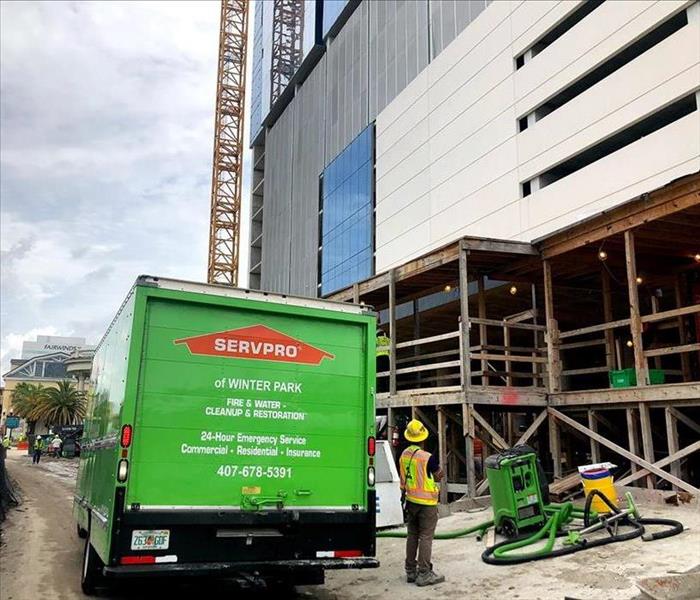 Choosing a company that can arrive quickly with the proper manpower and equipment is essential no matter the situation when water or fire is involved.
Choosing a company that can arrive quickly with the proper manpower and equipment is essential no matter the situation when water or fire is involved.
When your home or business is damaged by water, fire, or other disaster, it's important to act quickly to prevent further damage. That's why it's so important to choose a damage restoration company with fast on-site response times.
SERVPRO of Winter Park is located right near I-4 near downtown Orlando, so we can arrive at your property quickly to assess the damage and start the restoration process. We understand that time is of the essence, and we'll do everything we can to get your property back to normal as quickly as possible.
Here are some of the benefits of choosing a damage restoration company with fast on-site response times:
- Reduced damage: The sooner the restoration process begins, the less damage will occur to your property. This can save you money on repairs and cleanup.
- Prevention of further damage: If the damage is not addressed quickly, it can spread to other areas of your property. This can lead to even more damage and higher repair costs.
- Peace of mind: Knowing that you're in the hands of a qualified restoration company that can respond quickly to your needs will give you peace of mind during a stressful time.
If you've experienced a disaster, don't wait. Call SERVPRO of Winter Park today at (407) 678-5391 to get started with the restoration process. We'll be there quickly to help you get your property back to normal.
Here are some additional tips for choosing a damage restoration company:
- Get multiple estimates from different companies.
- Make sure the company is licensed and insured.
- Ask about the company's experience with the type of damage you've experienced.
- Get references from previous customers.
SERVPRO of Winter Park is a trusted leader in damage restoration. We have over 20 years of experience and a proven track record of success. We're committed to providing our customers with the best possible service, and we'll do everything we can to get your property back to normal as quickly as possible.
Call us today at (407) 678-5391 to learn more about our services.
How to Prepare Your Property for a Storm in Central Florida
6/29/2023 (Permalink)
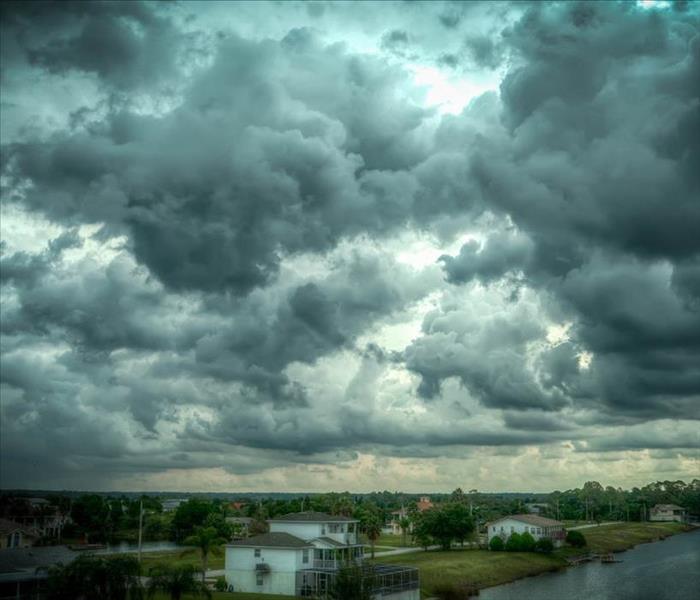 Florida is no stranger to frequent storms, especially during hurricane seasons.
Florida is no stranger to frequent storms, especially during hurricane seasons.
Living in Central Florida
Living here means being prepared for all kinds of storms, from hurricanes to thunderstorms. While you can't control the weather, you can take steps to protect your property from storm damage.
Here are some effective ways to prepare your property for a storm:
- Trim trees and shrubs away from your home or business. Fallen branches can cause a lot of damage, so it's important to trim trees and shrubs that could fall on your property during a storm.
- Inspect your roof for any damage. If you see any loose shingles or missing tiles, repair them as soon as possible. A damaged roof can let in water during a storm, which can cause extensive damage to your home or business.
- Secure loose items outdoors. This includes things like patio furniture, garbage cans, and toys. Anything that can be blown around by the wind can cause damage to your property.
- Bring in outdoor furniture and decorations. This will help to protect them from wind and rain damage.
- Disconnect any outdoor appliances or equipment. This includes things like lawnmowers, grills, and generators. If these appliances are damaged by a storm, it could pose a safety hazard.
- Have a plan for what you will do if you lose power. This may include having a generator, flashlights, and batteries on hand.
- Have a plan for how you will communicate with family and friends if you are separated during a storm. This may include having a designated meeting place or using a communication app like Zello or What'sApp.
If you do experience storm damage, it's important to contact a professional restoration company right away. Storm damage restoration companies can help you to assess the damage, remove debris, dry out the affected area, and repair or replace any damaged property.
SERVPRO of Winter Park is a leading storm damage and water damage restoration company in Central Florida. We have the experience and expertise to help you get your property back to normal after a storm. Contact us today for a free estimate.
Here are some additional services that storm damage and water damage restoration companies provide:
- Mold remediation: Mold can grow quickly in wet areas, so it's important to have it removed by a professional as soon as possible. Storm damage and water damage restoration companies have the experience and equipment to remove mold safely and effectively.
- Structural repair: If your property has sustained structural damage, such as a collapsed roof or a damaged foundation, you will need to have it repaired by a professional. Storm damage and water damage restoration companies have the expertise to repair structural damage and make your property safe to live in again.
- Content restoration: If your property has been damaged by a storm, you may need to have your belongings restored. Storm damage and water damage restoration companies can help you to salvage and restore your belongings, such as furniture, clothing, and electronics.
If you have experienced storm damage, don't hesitate to contact a professional restoration company. With the help of a qualified restoration team, you can get your property back to normal and start rebuilding your life.
Clearing the Air: Debunking Common Misconceptions About Cleaning Mold
6/23/2023 (Permalink)
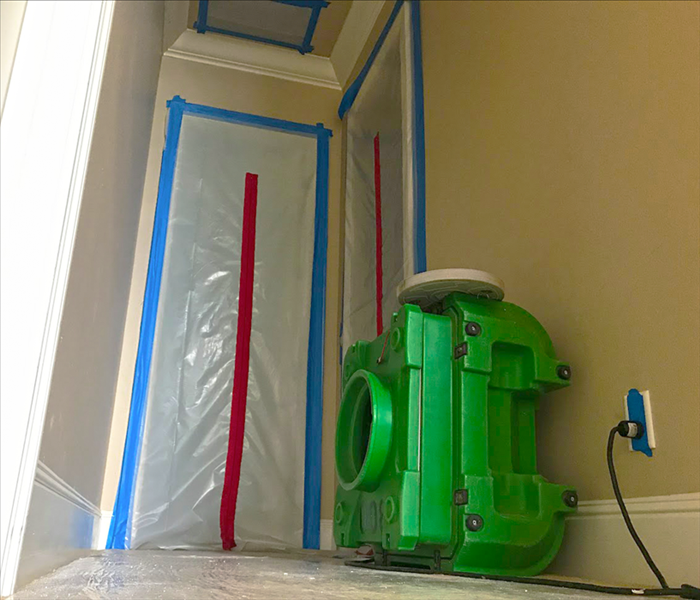 Disturbing mold can cause the mold to quickly produce a larger amount of airborne spores. Remediation experts contain the area beforehand.
Disturbing mold can cause the mold to quickly produce a larger amount of airborne spores. Remediation experts contain the area beforehand.
Mold growth is a common concern for both residential and commercial properties. It thrives in damp and humid environments, posing potential risks to structures and compromising indoor air quality. However, there are several misconceptions surrounding the cleaning and remediation of mold. In this article, we aim to debunk these myths, shed light on what indoor mold is, explore the causes of its growth, discuss common mold types, and clarify the roles of licensed mold assessors and remediation companies.
Understanding Indoor Mold:
Indoor mold refers to fungal growth that occurs within buildings, often in areas with excessive moisture and inadequate ventilation. It can manifest in various forms, including black, green, or white patches on surfaces, musty odors, and visible signs of water damage. Mold reproduces through spores, which can become airborne and spread throughout a property, potentially leading to further contamination if not addressed promptly.
Common Causes of Mold Growth:
Moisture Intrusion: Leaky roofs, plumbing issues, or poor insulation can introduce moisture into buildings, creating an ideal environment for mold growth.
Humidity: High humidity levels, especially in areas with limited airflow, contribute to moisture buildup and create a conducive atmosphere for mold to thrive.
Condensation: Improper ventilation, particularly in bathrooms, kitchens, and basements, can cause condensation on surfaces, promoting mold growth over time.
Flooding or Water Damage: Untreated water intrusion from floods, leaks, or burst pipes can create significant mold problems if not properly remediated.
Debunking Common Mold Cleaning Myths:
Myth 1: Bleach Kills Mold Completely: Contrary to popular belief, bleach is not an effective long-term solution for mold remediation. While it can help remove mold stains temporarily, it does not address the underlying issue or prevent regrowth. Professional mold remediation methods involve comprehensive removal and thorough cleaning of affected areas.
Myth 2: DIY Methods are Sufficient: While small mold problems might seem manageable, it's essential to understand that visible mold is often an indication of a more extensive issue hidden within walls, ceilings, or other concealed spaces. DIY attempts may not fully eradicate the problem, leading to recurring mold growth and potential structural damage. Professional assessment and remediation are crucial for thorough and lasting results.
Common Indoor Mold Types:
Stachybotrys Chartarum (Black Mold): This greenish-black mold is often associated with water-damaged materials and has gained notoriety with the public. Prompt remediation is essential when dealing with this type of mold.
Aspergillus: Aspergillus mold can come in various colors and is commonly found in HVAC systems, damp areas, and improperly stored food. Some species of Aspergillus can produce mycotoxins, making professional remediation necessary.
Cladosporium: Cladosporium is a widespread mold found both indoors and outdoors. It can grow on damp surfaces, such as carpets, fabrics, and wood, and is known to trigger allergies and respiratory issues in susceptible individuals.
The Role of Licensed Mold Assessors and Remediation Companies:
Licensed mold assessors conduct thorough inspections and testing to identify the presence of mold, determine the extent of contamination, and assess potential causes. They provide detailed reports and recommendations, guiding property owners in making informed decisions regarding remediation strategies.
Licensed mold remediation companies specialize in safely and effectively removing mold from affected areas. They employ industry-standard protocols, such as containment measures, air filtration, proper disposal of contaminated materials, and the use of specialized cleaning agents to ensure thorough remediation.
The State of Florida does not allow a single company to hold both an assessor's and a remediator's license. This is to help prevent foul play with the potential conflict of interest having both licenses could lead to. Be wary of companies claiming to do both sides of a mold job. A professional mold assessor will create a detailed protocol on how your specific mold situation should be remediated and a professional remediation company will request that protocol before performing any work to ensure the problem is handled correctly with the least possible chance of returning growth.
Conclusion:
Clearing up misconceptions surrounding mold cleaning is crucial for effectively addressing mold
Understanding Homeowners' Insurance Policies for Water, Mold, and Fire Damage in Florida
5/31/2023 (Permalink)
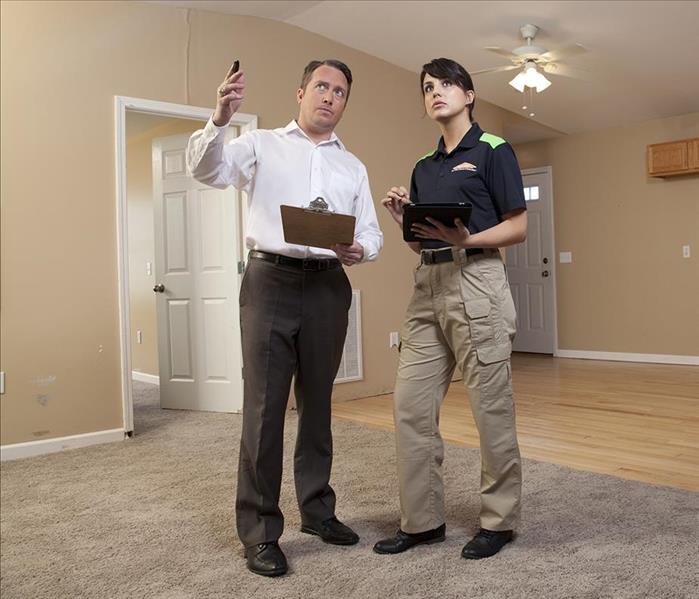 SERVPRO® works closely with your insurance to help move the process along.
SERVPRO® works closely with your insurance to help move the process along.
As a homeowner in Florida, it's essential to be familiar with the different insurance policies that can protect your property from potential risks such as water damage, mold growth, and fire incidents. Understanding how these policies cover the cost of restoration can help you make informed decisions and ensure your home is adequately protected. In this blog post, we will explore the common insurance policies that Florida homeowners have in relation to water, mold, and fire damage, and highlight how SERVPRO of Winter Park works closely with homeowners' insurance companies to streamline the restoration process.
Homeowners' Insurance and Water Damage:
Water damage is a common concern for homeowners, especially in a state like Florida that experiences heavy rainfall and the occasional hurricane. In many cases, homeowners' insurance policies provide coverage for sudden and accidental water damage, such as burst pipes, plumbing leaks, or roof leaks. It is important to review your policy to understand the specific coverage limits and exclusions. SERVPRO of Winter Park can work with your insurance company to assess the damage, document the restoration process, and ensure a smooth claims process.
Insurance Coverage for Mold Remediation:
Mold growth can result from water damage or excessive humidity, and it can cause significant damage to your property and pose health risks. Most homeowners' insurance policies do not automatically cover mold remediation, but some may offer limited coverage if the mold growth is a result of a covered water damage event. It's crucial to review your policy and consider purchasing additional coverage specifically for mold remediation. SERVPRO of Winter Park has extensive experience in mold remediation and can provide the necessary documentation and assistance to support your insurance claim.
Fire Damage and Homeowners' Insurance:
Fire incidents can have devastating consequences for homeowners, causing not only property damage but also emotional distress. Fortunately, homeowners' insurance policies typically cover fire damage and offer financial protection for the restoration process. These policies may cover not only the cost of repairing or rebuilding the damaged structure but also the replacement of personal belongings. SERVPRO of Winter Park can collaborate with your insurance company and adjusters to ensure that all fire damage restoration needs are accurately assessed, documented, and addressed promptly.
Working with SERVPRO of Winter Park:
When faced with water, mold, or fire damage, the restoration process can be overwhelming. However, partnering with a professional restoration company like SERVPRO of Winter Park can make the experience easier and more efficient. Our team has extensive experience in working closely with homeowners' insurance companies and adjusters to streamline the restoration process. We understand the documentation requirements, provide detailed reports, and work to ensure that your claim is handled smoothly.
Conclusion:
As a homeowner in Florida, it's crucial to have a clear understanding of your homeowners' insurance policies and how they cover water, mold, and fire damage. Review your policy regularly to ensure you have adequate coverage and consider additional coverage if necessary. In the event of a disaster, SERVPRO of Winter Park is here to assist you throughout the restoration process. We have the expertise, experience, and close working relationships with insurance companies to help you navigate the claims process seamlessly. Contact SERVPRO of Winter Park today to learn more about our services and how we can assist you in restoring your home after water, mold, or fire damage.





 24/7 Emergency Service
24/7 Emergency Service